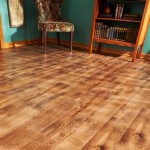If you’re installing laminate flooring in your home, you want the job to look professional and last for a long time. That means you need to make sure you have the right underlayment for your laminate flooring. Underlayment is a thin material that goes between the subfloor and the laminate flooring to provide cushion, insulation, and soundproofing.
Types of Underlayment for Laminate Flooring
Underlayment for laminate flooring comes in two main types: foam and cork. Foam underlayment comes in either a roll or sheet form and is usually made of polyethylene or polypropylene. It provides a soft cushion between the subfloor and the laminate flooring, as well as insulation and soundproofing. Foam underlayment also helps to reduce the amount of noise that is generated when walking on the laminate floor.
Cork underlayment is usually made of recycled cork and is available in either roll or sheet form. It is also a great choice for soundproofing and insulation, but it has the added benefit of being more environmentally friendly than foam underlayment. Cork also provides a slight cushion and can help to reduce the amount of moisture that seeps into the subfloor.
Which Underlayment Is Best for Laminate Flooring?
The best underlayment for your laminate flooring depends on the type of subfloor you have and the level of soundproofing and insulation you need. If you have a concrete subfloor, foam underlayment is usually the best choice, as it provides the most cushion and insulation. If you have a wooden subfloor, cork underlayment is the better choice, as it helps to reduce the amount of moisture that seeps into the subfloor.
Other Considerations for Underlayment
When selecting an underlayment for your laminate flooring, you should also consider the thickness of the underlayment. The thicker the underlayment, the more cushion and insulation it will provide. However, thicker underlayment may also increase the cost of the project. You should also consider the area where you’re installing the flooring. If you’re installing in a room that is prone to moisture, such as a bathroom or kitchen, you may want to look for an underlayment that is moisture resistant.
Installing Underlayment for Laminate Flooring
Once you’ve selected the type of underlayment you need, it’s time to install it. The first step is to clean the subfloor to ensure that it is free of dirt, dust, and debris. Then, you should lay down the underlayment and cut it to fit the room. Make sure to leave a gap between the walls and the underlayment to allow for expansion. Finally, you can install the laminate flooring on top of the underlayment.
Conclusion
Installing the right underlayment for your laminate flooring is an important step in ensuring a long-lasting, professional looking installation. There are two main types of underlayment for laminate flooring: foam and cork. The best type of underlayment for your project depends on the type of subfloor you have and the level of soundproofing and insulation you need. Once you’ve chosen the right type of underlayment, you can install it and then lay down the laminate flooring.
/Laminate-floor-install-GettyImages-154961561-588816495f9b58bdb3da1a02.jpg)

/new-floor-installation-185270632-582b722c3df78c6f6af0a8ab.jpg)









:max_bytes(150000):strip_icc()/underlayment-for-laminate-flooring-1822245_01-cad66fe5f1ab47b28c30a7d9ccfb702c.jpg)
Related Posts








